“Everybody lies,” says the popular TV series protagonist. This holds especially true in recruitment. As the 2023 survey informs, which is based on 1,900 participants, 8 of 10 candidates lie on their job interviews.
Answering the question, “Have you ever been dishonest during your job interview?” the applicants responded the following:
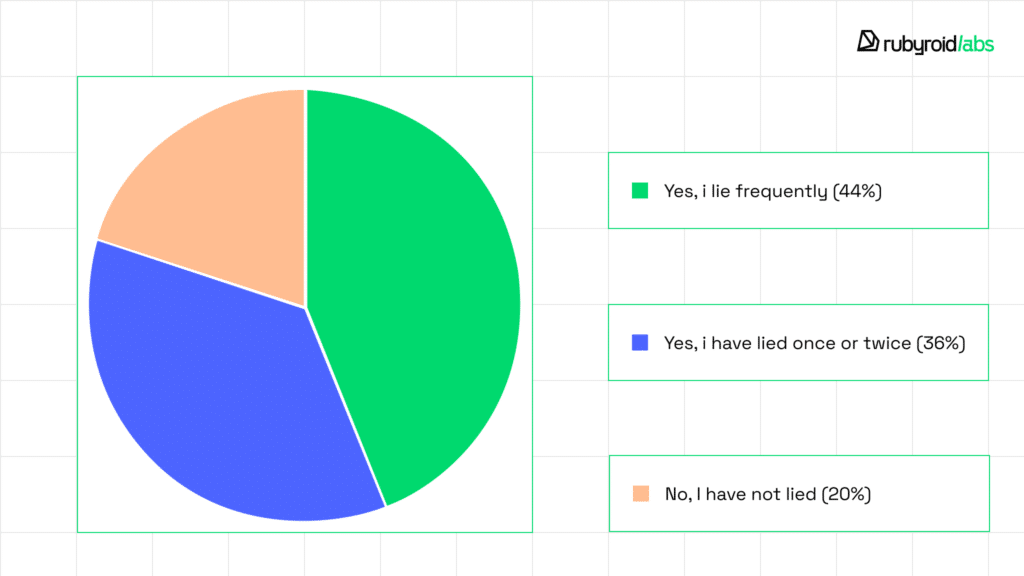
So, finding a truly good specialist can be pretty tough.
To build a dream team, you’ll need some solid headhunting strategies that really work, helping crack the wrong candidates at once.
Together with our Head of HR department, Tatiana, we’ve crafted this post to share with you our experience in talent recruitment. Our hiring and recruiting strategies have been proven over 11 years, so you can use them in searching for developers for your project.
Rubyroid Labs is one of the top web development companies in 2023, according to Clutch.co, with over 45 verified client reviews ranked 5.0 on the B2B platform. Our developers are praised by clients for their communication skills, problem-solving abilities, high-quality work, and timely deliveries of tasks.
If you need top Ruby on Rails developers, Golang programmers, or strong specialists in UI/UX design, drop us a line to discuss your needs and form a project estimate.
Contents
- Challenges in Hiring and Retaining Developers
- 6 Best Hiring and Recruiting Strategies for a Project Owner
- Top Skills to Notice When Hiring a Software Engineer
- Final Words
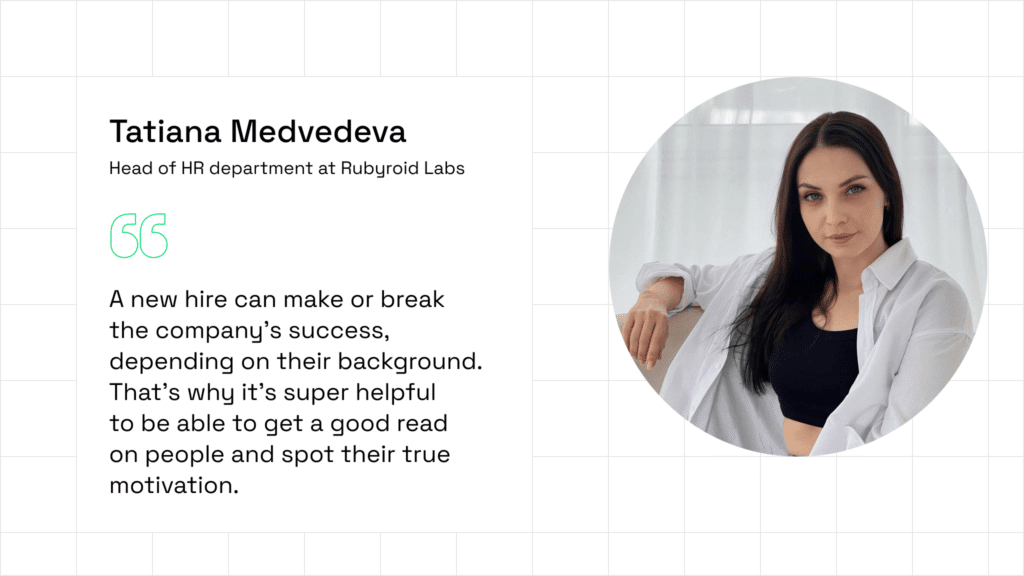
Let’s uncover challenges in employees’ hiring and the top red flags hidden in human personalities.
Challenges in Hiring and Retaining Developers
Q: Tatiana, you’ve been working in headhunting for over 5 years. What can you say about the difficulties in the market for tech specialists today?
A: We do face some immediate challenges in our recruiting process. Depending on the vacancy, hunting a specialist with strong hard and soft skills can be a tough nut to crack. A candidate might sugarcoat their CV, and the ‘surprise’ only becomes evident during the interview. However, that’s not the only problem that we’re facing today. I’d highlight several key challenges.
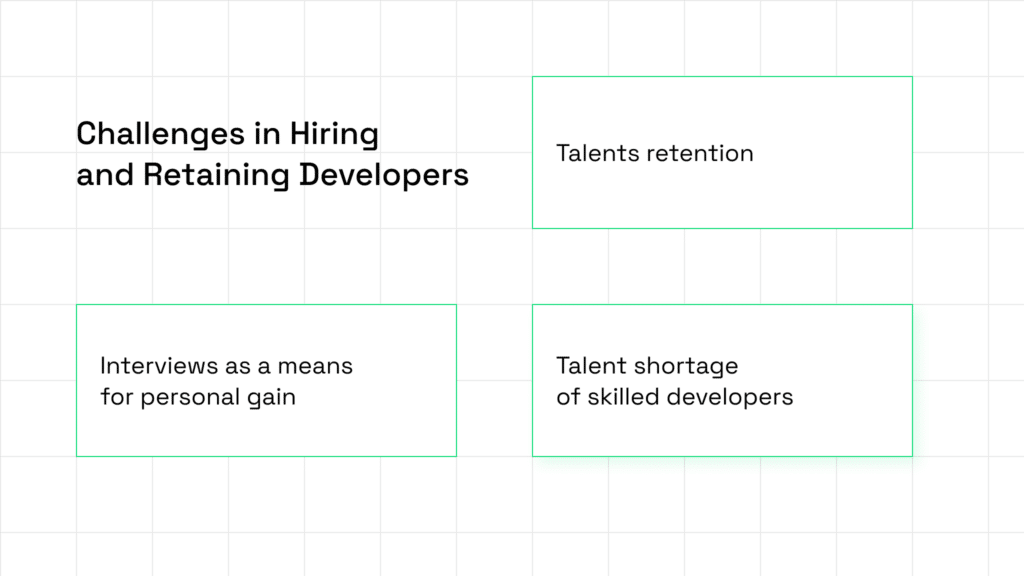
- Talent shortage of skilled developers. This is a big pain point, especially in specific technologies like Ruby on Rails or Golang. I think the problem is that young specialists fall for trends and focus on more widespread programming languages while companies like ours work with niche technologies. So, filling the position can take way longer than we’d like.
- Interviews as a means for personal gain. The scenario develops like this: a developer seems really interested in the position, submits their CV, and actively discusses the role. But then they either ghost you or use the interview as a bargaining chip to get a promotion or better opportunities at their current job. That’s really frustrating and time-consuming. And at this point, you need to develop an eye for spotting these types of candidates early on.
- Talents retention. That’s the flip side of the previous point. As developers have numerous opportunities worldwide, they may be tempted to jump ship if they lose motivation at their current company. This is often why they attend interviews with other companies and keep an eye on career advancement opportunities. Companies need to regularly think about what they can offer to keep their top talents.
Q: Thank you for outlining these problems. We’re sure you have some tips to share for recognizing the wrong candidates, do you?
A: Well, every HR specialist becomes a bit of a psychologist after years of experience. So, I can point out a few red flags that might indicate you’re dealing with a less-than-great specialist.
Top Red Flags of a Poor Candidate in a Job Interview

1. ‘Watery’ and inconsistent answers
The candidate answers too vaguely and generally about their experience, work on previous projects, and hides the reasons for leaving their previous job.
How to spot? Ask follow-up questions that demand more details. Pay attention to the candidate’s body language, such as eye contact and microexpressions. If they struggle to discuss their experience, it could be a sign of dishonesty.
2. Low level of communication skills
The interviewee struggles to express their thoughts clearly, explain complex technologies or demonstrate problem-solving skills. A huge red flag in this point is also the use of passive-aggressive language or toxic remarks.
How to spot? If something feels off, it probably is. You’ll be working with this person on a project and solving various issues. So, keeping healthy communication within the team is vitally important. See how the applicant speaks out about technical and non-technical topics and trust your feelings.
3. Badmouthing previous jobs
The job seeker reacts too negatively when talking about their past projects, ex-colleagues, or bosses.
How to spot? Ask them about the company or projects they left and why. If their response is full of criticism and complaints, it could indicate they struggle to handle conflicts in a healthy way.
4. Not open for changes
The candidate feels uncomfortable or shows hesitation when discussing new tools or technologies, changes in the project, or they stick to “the way things have always been done.” This can be a big warning sign, especially in industries where things move fast.
How to spot: Observe what the interviewee says about overcoming the changes. If they get stuck on the detailed description of difficulties or seem resistant to talk about new ways of doing things, it can show that they have troubles with adaptability.
Being resistant to changes can be a big issue, especially in dynamic industries like tech, where flexibility is super important.
6 Best Hiring and Recruiting Strategies for a Project Owner
Q: Tatiana, thank you for sharing such valuable insights. In this section, we’d like to dive into recruiting and interview strategies for successful hiring. Can you walk us through your best hiring and recruiting strategies?
A: Of course! We do have a general set of strategies, but we tweak things depending on the role we’re hiring for. For example, hiring UX designers is a bit different from the hiring strategy for software engineers. It’s all about adapting the process to fit the needs of the position.
Let me break down what really works for us.
1. Starting with a Clear Request
The first thing we do before starting the hiring process is point out what kind of person we need. Together with the relevant department, we create a detailed profile that includes:
- the project or the product to work on
- the key tasks
- the specific requirements for the position
We also map out the must-have skills and nice-to-have skills, both hard and soft. The clearer the request, the better.
2. Setting a Realistic Budget
At this stage, we keep our finger on the pulse of the market to stay updated on salary trends for the position. This helps us attract the right candidates and avoid any surprises during salary talks.
3. Pointing Out the Key Stakeholders
We identify the people responsible for preparing test assignments, if needed, and for attending the interviews to assess the candidate’s professional skills. We involve everybody in the hiring process, from technical leaders to team members, and explain their role in the process. It’s like a well-oiled machine.
4. Keeping Communication Smooth
In our company, we always try to keep a warm and friendly atmosphere right from the first messages of our HR specialist till the end of the job interview.
We understand that interviews can be stressful, so we do our best to ease the tension at the start of the dialogue.
We give detailed info about the project, team culture, and growth opportunities. No sugar-coating—just honest conversations about what we offer and what we expect.
5. Using Various Resources in Headhunting
One of our most common methods for searching for tech talent is LinkedIn. If you know how to use it correctly, you can find great candidates from all over the world.
It’s important to use the right keywords and craft messages that truly grab their attention. But here’s the key: we don’t just use LinkedIn for recruitment; we also focus on building our brand presence. When developers know and trust your company, half the job is done.
Q: Wow, perfect! And do you use any other searching methods?
A: Yes, referral programs work really well for us. In this case, we have a good idea of who’s coming in for an interview, and the candidate already knows what to expect from someone they trust who referred them. Plus, it can make the onboarding process smoother since they’ll already have a familiar face inside the company.
Networking also works great. When people know you and what your company does, you might even get messages from people you don’t personally know but who are interested in joining.
6. Making the Interview Process Short and Simple
We keep the interview process short and to the point. Two interviews are usually enough for us to make a decision. After that, we begin the onboarding process, which typically lasts three months. Each newcomer gets a buddy and a mentor to help them smoothly integrate into the work environment.
We also hold one-on-one meetings to ensure the new team member is settling in well. It’s like having a safety net while they find their feet.
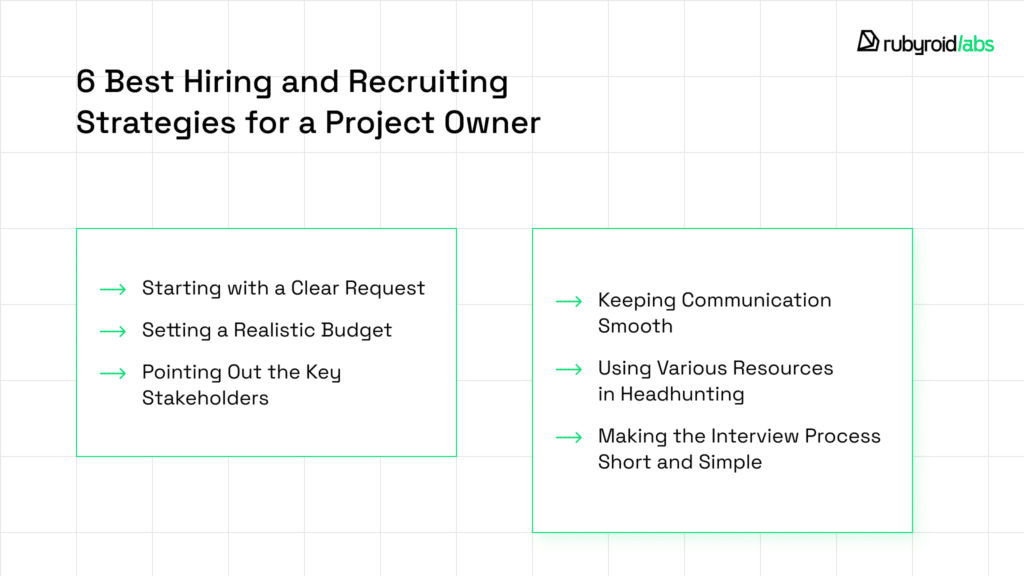
Q: What about using any special software or AI for headhunting? Do you use any tools in your practice?
A: It’s really helpful for recruiters to use CRM systems to automate processes, manage a candidate database, and ensure no one slips through the cracks. A CRM helps track the entire candidate pipeline, so you can see where things might be falling short. By analyzing the hiring process, you can identify weak points, figure out what needs to be improved, and understand at which stage candidates are dropping off.
As for AI, I do use it, but not for processing CVs—especially since uploading personal data into AI tools isn’t a good idea. Instead, AI is great for things like writing job descriptions, crafting outreach messages, drafting responses, and even brainstorming search strategies. You can even use AI to rehearse interviews and come up with interesting questions to ask candidates.
Q: Tatiana, we’re absolutely sure your recruiting strategies for hiring great employees will help many companies improve their headhunting process.
Now, let’s move on to our next topic where we’ll figure out which skills to focus on when headhunting a developer.
Top Skills to Notice When Hiring a Software Engineer
Q: You’ve hired lots of people in your career. What skills should a good software engineer have?
A: Well, today a great software engineer needs more than coding skills. We pay much attention also to soft skills, which sometimes are not that easy to find. While technical knowledge can always be improved, soft skills are much harder to teach because they’re often tied to personality.
Here’s a checklist of the top skills you should be looking for when hiring a software engineer:
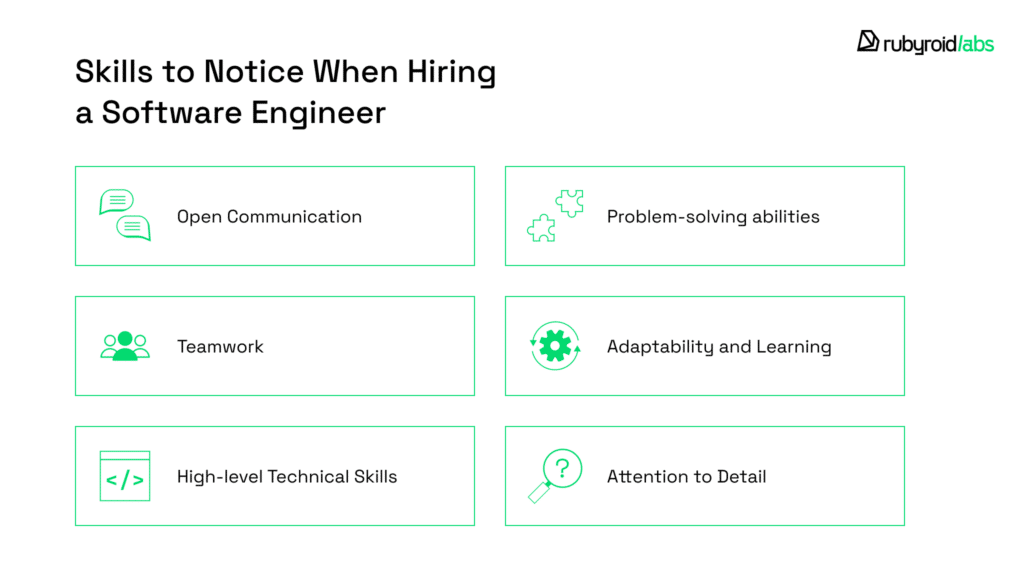
High-level Technical Skills
Of course, technical skills are the basis. You’ll need someone who not only understands the appropriate programming languages and frameworks but also can adapt to new tools and technologies. The best engineers are those who can use their technical know-how to solve real-world problems.
Open Communication
In our company, communication skills are just as important as technical skills. When a developer can explain complex technical concepts in a simple way, actively listen, ask the right questions, and overall maintain a friendly, toxic-free environment within the team—that’s a developer worth their weight in gold. Our advise is choose engineers with strong communicative skills.
Teamwork
Coding may appear to be a solo activity, but effective software engineers understand the value of teamwork. Whether they’re working with other engineers, designers, or product managers, they need to be comfortable sharing ideas, participating in group discussions, and supporting their colleagues.
Problem-solving abilities
Engineering is all about solving problems. Whether it’s fixing bugs or designing a system from scratch, software engineers need to approach challenges logically and creatively. Look for candidates who can break down problems, think critically, and come up with effective solutions—even under pressure.
Adaptability and Learning
Technology evolves quickly, and so should your engineers. The best candidates are those who are interested in new technologies, trendy tools, or other programming languages. It’s a great idea when developers organize meetings to discuss industry news or share their experiences with others. This is something we actively practice at Rubyroid Labs to maintain the overall skill level of our developers.
Attention to Detail
A skilled software engineer has an eye for detail. Being meticulous helps make fewer mistakes and leads to higher overall quality, from creating clean, efficient code to detecting potential errors early on.
This skill is crucial for debugging and testing, where even the smallest oversight can lead to big problems later on.
Q: That’s a comprehensive list of skills! It sounds like hiring a developer is about finding a balance between technical expertise and interpersonal qualities.
A: Exactly! When companies invest time and effort into building a strong development team, it really pays off. We’ve seen how a well-crafted team leads to excellent client feedback. Happy clients not only come back with new projects but also become our advocates – they recommend us on B2B platforms and within their professional networks.

Final Words
To attract top talent, you need a solid plan, effective hiring and recruiting strategies, and a lot of patience.
However, there still appear cases where employees behave inappropriately, wasting your time and efforts while the project can’t wait.
If finding the right specialist proves too challenging, we can help. We have carefully vetted, highly skilled development teams available for outsourcing. Our developers not only excel technically but have also worked together in teams for 3-5 years on average.
Contact us to discuss your requirements and find the technical expertise you need for your project.



